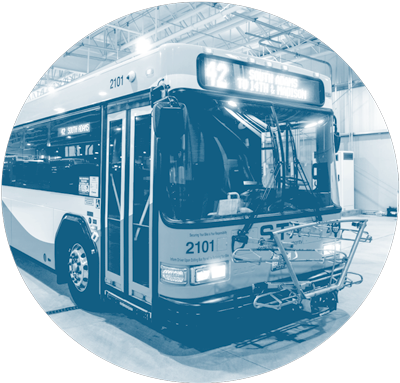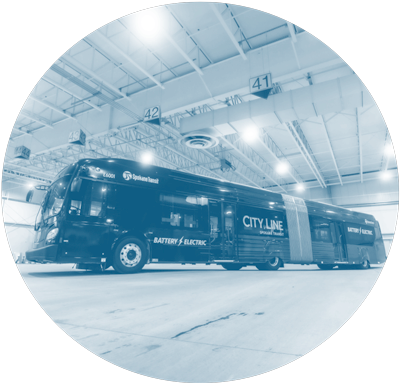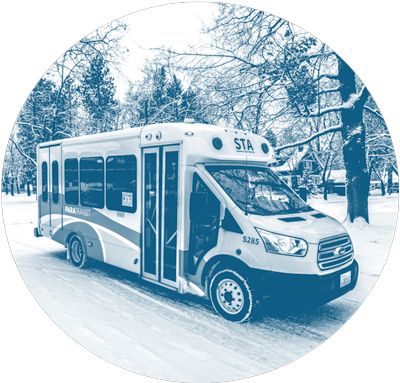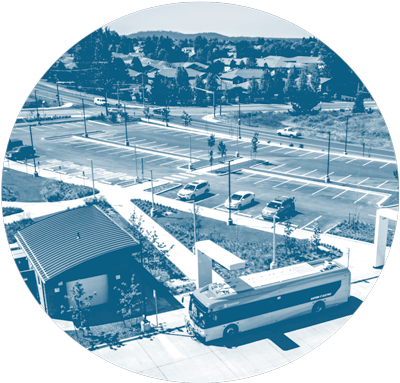Frequently Asked Questions
about Division Street BRT
About BRT
Bus Rapid Transit (BRT) is a public transportation system that creates more reliable and efficient service than traditional buses. BRT provides all-day, two-way, reliable and frequent service at distinct station locations. Buses arrive more frequently so riders can just “show up and go” without needing to check a schedule.
Many large cities, like Spokane, must have a strong and reliable transit network to accommodate population growth and the needs of community members. STA serves the greater Spokane region across nearly 250 square miles.
Local investments in roadways, traffic facilities, and stations along the BRT route will be fundamental to providing enhanced services. Electric bus fleets lower greenhouse gas emissions, improving public health with better air quality. Increased opportunities for pedestrian and cycling activities as well as better options compared to private vehicles.
Spokane is one of the highest growth markets in the country with new residents coming from major metro markets like Seattle, Portland, and cities in California. With this influx of new residents comes an increased need, and expectation, for sophisticated, reliable and sustainable transit options.
Today, STA buses can only access and use general traffic lanes resulting in challenges with increased traffic as buses cannot go any faster than existing road traffic. During peak times, especially rush hour, this can significantly impact bus schedules.
With the exception of the City Line, STA’s fixed route buses do not allow for prepaid fares, near-level boarding, or boarding with all doors, significantly slowing the time during which a rider can board the bus.
Business Access and Transit (BAT) lanes are shared-use lanes for right-turning vehicles and bus-through travel that help buses to move more efficiently through traffic and provide safer access to businesses. BAT lanes allow vehicles, including deliveries, to turn into and out of driveways.
BAT lanes enhance the capacity of traffic lanes by removing buses from the public travel lanes. Vehicles don’t get stuck behind the bus as it travels through Division. Turning into businesses is safer because you have better visibility and opportunity to turn.
A locally preferred alternative, or LPA, is an alternative evaluated through a local planning process, adopted by the project proponents through a public process. This alternative includes a preferred transit vehicle and route that best meets the needs of the corridor. The selected LPA serves as the foundational vision for BRT.
About the Division Corridor BRT
Division Street is one of the busiest streets in Spokane serving as the main north-south street connecting communities between downtown up to the Y and further north.
Every day, more than 50,000 cars travel on Division Street with close to 2,500 people riding STA transit buses.
The timing of the BRT project is in alignment with the completion of the North Spokane Corridor. The Division Street BRT project will not be operational until the North Spokane Corridor is open.
The BRT will run north-south from downtown Spokane, along Division and Ruby Streets past the “Y” to Hastings Road then east near the North Spokane Corridor freeway (NSC) locations.
In 2021, the Division Street BRT LPA was finalized and adopted by the STA Board of Directors. The LPA includes four key elements:
- The route for future BRT service will run north-south from downtown Spokane, along Division and Ruby Streets past the “Y” to Hastings Road then east near the North Spokane Corridor freeway (NSC), Roadway cross sections.
- There will be 44 stations located along the alignment
- Planned service schedules that will include buses arriving every 15 minutes or better during most weekday, night and weekend operating hours.
- Plans to convert one existing general-purpose lane in each direction to a BAT lane.
Lanes are not being removed on the majority of the corridor, but converted into BAT lanes. One lane of Ruby Street through the couplet will be converted into two-way protected bicycle lanes and improved pedestrian facilities.
These conversions will promote active transportation and improve the efficiency of transit
Traffic flow is not expected to be impacted due to decreased traffic volumes that are expected to be diverted to NSC corridor. In fact, travel times may improve as traffic is not held up by stopping buses or cars making right hand turns.
BRT stations will be located at major intersections and near destinations.
Current plans have buses operating at 10-minute frequencies during weekdays and 15-minute or less frequencies on nights and weekends.
Provided that preliminary engineering work is completed, construction work is expected to begin in 2027.
Construction is expected to last 2-3 years. Provided that all decisions are made and approved, and funding is received, construction is expected to be completed by 2030.
As with any construction project of this size, there will be many detour routes made available to ensure that travelers can get to their destinations as seamlessly as possible. Construction updates and plans will be shared on the STA and WSDOT websites, social media, and with the help of local news partners.
The first Spokane BRT, City Line, is expected to bring an economic impact of $175 million into the Spokane region over 20 years. Given the magnitude and expected benefits of Division Street BRT, that number will be far surpassed by the second BRT line.





